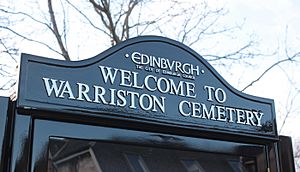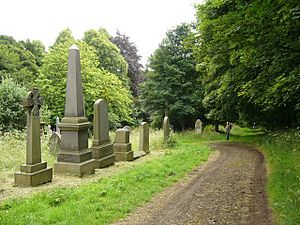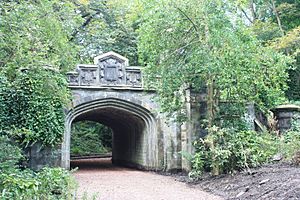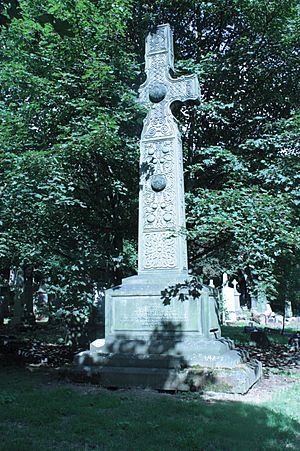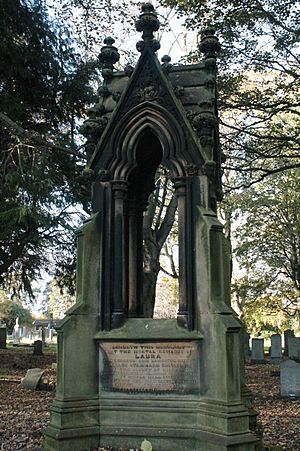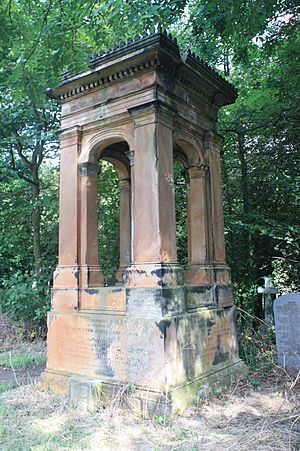Warriston Cemetery facts for kids
Warriston Cemetery is a large, historic cemetery located in Warriston, a northern area of Edinburgh, Scotland. It was created by the Edinburgh Cemetery Company and covers about 14 acres of land. Many thousands of people are buried here, including important figures from the Victorian and Edwardian eras. One of the most famous people buried here is Sir James Young Simpson, a doctor known for his work with medicine.
The cemetery is found north of the Water of Leith river. It has a beautiful landscape, with some parts designed and others now wild due to not being maintained. It is part of the Inverleith Conservation Area and is also a special Local Nature Conservation Site. The cemetery itself is a protected historic building, known as a Category A listed building.
In July 2013, a group called the Friends of Warriston Cemetery was started. Their goal is to share the cemetery's history and help protect its natural plants and animals.
Contents
History of Warriston Cemetery
The cemetery was planned in 1842 by an Edinburgh architect named David Cousin. It first opened its gates in 1843. The very first person buried here was Margaret Parker, on June 3, 1843.
Warriston was Edinburgh's first "garden cemetery." This means it was designed to be a peaceful, park-like space, not just a burial ground. It became a model for other cemeteries in Scotland. Its design was inspired by Kensal Green Cemetery in London. Part of its original design included a line of catacombs, which are underground burial chambers. These catacombs were made twice as long in 1862 by architect John Dick Peddie. A chapel that used to stand above the catacombs was taken down by 1930.
Soon after it opened, in 1845, the cemetery was split in two by the Edinburgh, Leith and Newhaven Railway. This railway was built through the southern part of the cemetery. A tunnel with Gothic archways was added to connect the northern and southern sections. However, the southern part became less important after this. The railway stopped running in the 1950s, and the old tracks are now a public walking path.
In 1929, the Edinburgh Cemetery Company started offering cremations. They turned East Warriston House (built in 1818) into Warriston Crematorium. This building is next to the cemetery. The famous architect Sir Robert Lorimer designed it, and the main chapel is still called the Lorimer Chapel. The crematorium was made bigger in 1967. The cemetery lodge, a small house at the entrance, was built in 1931.
The cemetery was privately owned until 1994. Then, the City of Edinburgh Council bought it. Since then, work has begun to restore the cemetery, which had become very overgrown and damaged. However, there is still a lot of work to do. Only the upper (western) part is currently looked after. Many areas are so overgrown that the gravestones are hidden by plants.
Some people feel that the overgrown nature of the cemetery makes it even more special. It can be magical to walk among the headstones covered in ivy, with tall trees forming a natural, quiet space.
Interesting Monuments
Warriston Cemetery has several interesting monuments. One was the Robertson mortuary chapel, built in 1865 for Mary Ann Robertson. It had a white marble statue of a woman and a red glass roof. People called it the "Tomb of the Red Lady." Sadly, it was badly damaged and had to be taken down in the late 1980s.
The grave of Sir James Young Simpson is still visible. He was a very important doctor who helped develop anaesthetics, which are medicines that make you unable to feel pain during surgery.
You can also find works by famous sculptors here. These include a statue of William Young, a gardener, by William Birnie Rhind. There's also a monument to Robert Bryson by Thomas Stuart Burnett. Many beautiful and detailed Celtic crosses were made by the McGlashens. A large arched monument for Rev James Peddie is also notable.
Famous People Buried or Cremated Here
People Buried at Warriston
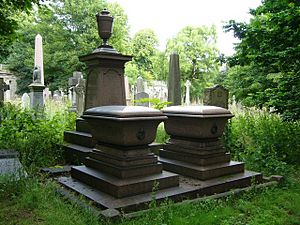
Many notable people are buried in Warriston Cemetery. Here are a few examples:
- Joseph Anderson (antiquarian) (1832–1916): A keeper at the National Museum of Antiquities.
- Robert Rowand Anderson (1834–1921): A well-known architect.
- John Hutton Balfour (1808–1884): A famous botanist, who studied plants.
- Adam Black (1784–1874): A publisher, a Lord Provost (like a mayor) of Edinburgh, and a Member of Parliament.
- Alexander Buchan (meteorologist) (1829–1907): He created the first map-based weather forecasts.
- Sir John James Burnet (1857–1938): Another important architect.
- Mary Crudelius (1839–1877): An early supporter for women's education.
- Robert Gibb (1845–1932): An artist famous for his painting The Thin Red Line.
- Sir George Harvey (1805–1876): A painter.
- Edith Hughes (architect) (1888–1971): Scotland's first female architect.
- Robert Jameson (1774–1854): A naturalist and mineralogist, who studied nature and minerals.
- Feliks Janiewicz (1762–1848): A Polish composer and violinist.
- James Jardine (1776–1858): A civil engineer.
- Philip Kelland (1808–1879): An English mathematician.
- Robert Scott Lauder (1803–1869): An artist.
- John Menzies (1808–1879): He founded the national newsagent chain that still carries his name.
- William Nicol (1770–1851): A physicist and geologist.
- Sir William Peck (1862–1925): An astronomer.
- Alexander Smith (1829–1867): A Scottish poet.
- John Smith (1825–1910): A surgeon and dentist, who was even Queen Victoria's dentist.
- Sir James Young Simpson (1811–1870): A pioneer in using anaesthetics.
- Sir John Struthers (1823–1899): A surgeon and anatomist.
- William Swan (physicist) (1818–1894): A physicist who discovered the Swan band.
- Sir William Taylour Thomson (1813–1883): A military officer and diplomat.
- Sir John Batty Tuke (1835–1913): A very important psychiatrist.
- Dr Catherine Jane Urquhart (1845–1902): An early female doctor.
- George Waterston (1808–1893): The founder of Waterstons Bookshop.
People Cremated at Warriston
The crematorium is a separate building next to the cemetery. It has special areas for remembering people, like a Rose Garden and a Water Garden. There is also a Book of Remembrance, which is opened to the correct date each day. A computer version lets you look up any date.
Some famous people whose ashes were cremated here include:
- Alfred Adler (1870–1937): An Austrian psychotherapist. His ashes were later moved to Austria.
- Sapper Adam Archibald (1879–1957): A VC recipient from World War I.
- Captain Charles George Bonner (1884–1951): A Royal Navy Victoria Cross recipient from World War I.
- Brigadier Arthur Edward Cumming (1896–1971): A VC recipient from World War II.
- Sir Robert Lorimer (1868–1929): The architect who designed the crematorium.
- Don Revie (1927–1989): A famous English footballer and manager.
War Graves
Warriston Cemetery is also home to 100 graves of Commonwealth service members. These include 72 from World War I and 27 from World War II. There is also a grave for a Belgian soldier. The CWGC has a special memorial here. It lists 142 Commonwealth service members from World War II who were cremated at Warriston.
Plants and Trees
The cemetery is known for its interesting trees. Among them are two purple-leaved elms and a concave-leaved elm. These are rare types of elm trees that existed before Dutch Elm Disease became a problem.
|
See also
 In Spanish: Cementerio de Warriston para niños
In Spanish: Cementerio de Warriston para niños


